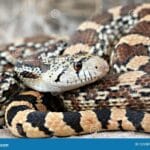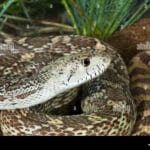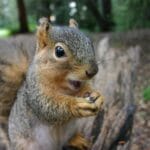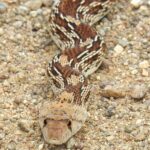Unearthing the Telltale Signs of Garden Intruders
So, you’ve got some mysterious digging going on in your backyard. While it’s easy to brush it off as a squirrel burying its treasure, the appearance of more holes and vanishing plants might point to a different culprit: a woodchuck or a gopher. Don’t worry; we’re here to help you distinguish between these burrowing bandits and reclaim your garden paradise.
Size and Style: A Matter of Tail and Scale
First things first, size matters. Picture a furry football with stubby legs – that’s your woodchuck, stretching out to about 20 inches. Gophers, on the other hand, are more akin to furry hotdogs, maxing out around 6-12 inches. Their smaller stature makes them trickier to spot.
Now, check out the tail – a key identifier. Woodchucks proudly display their bushy tails, a dead giveaway. Gophers, however, keep it sleek and subtle with short, hairless tails.
Digging Deep: Tools of the Trade
Ever catch a glimpse of those chompers? Woodchucks aren’t shy about flashing their large, ever-present front teeth. Gophers prefer a more discreet approach, keeping their teeth hidden behind their lips.
And speaking of clues, if you can safely observe their feet, you’ll notice another distinction. Woodchucks sport dark brown or black feet, while gophers strut their stuff with pinkish ones.
Home Sweet Burrow: A Look at Their Digs
Their underground dwellings also offer telltale signs. Woodchucks prefer spacious living, digging sizable holes with entrances often left wide open. Gophers, valuing their privacy, create more discreet crescent-shaped mounds with plugged entrances.
Their culinary preferences provide further clues. Gophers are root and bulb enthusiasts, which might explain your garden’s appeal. Woodchucks, however, are more interested in above-ground dining, munching on plants and vegetables.
Outsmarting the Diggers: Choosing the Right Strategy
When it comes to dealing with these digging enthusiasts, a tailored approach is essential. Trapping is a common tactic for both, but the type of trap and technique differ. Cage traps work well for woodchucks, while smaller, specialized gopher traps are designed for their diminutive size.
Location, Location, Location: Mapping Their Turf
Knowing their preferred hangouts can give you a head start on identification. Woodchucks favor the edges of forests and open fields, commonly found in the eastern and central US and Canada. Gophers have a broader range across North America, particularly fond of loose, sandy soil that’s perfect for tunneling – and might explain their attraction to your garden.
Beyond ID: The Importance of Knowing Your Enemy
Accurate identification is about more than just naming these critters; it’s about effective control. Mistaking a gopher for a woodchuck can lead to using the wrong methods, resulting in frustration and a vulnerable garden.
Living in Harmony: Can We All Just Get Along?
As our neighborhoods and developments expand, we inevitably impact woodchuck and gopher habitats, leading to conflicts. However, by employing humane control methods and understanding their behaviors, we can strive for coexistence.
Mythbusters: Busting Woodchuck Tales
Let’s address a common misconception: woodchucks don’t actually chuck wood. The name, stemming from a mispronounced Algonquian word “wuchak,” is a bit misleading.
In Conclusion: Knowledge is Power in the Garden
Protecting your garden and peacefully coexisting with these burrowing buddies starts with knowing the difference between a woodchuck and a gopher. Recognizing their unique characteristics, understanding their habits, and appreciating their role in the ecosystem allows us to find harmonious solutions. So, the next time you spot a suspicious mound in your yard, channel your inner detective and solve the case of the mysterious digger!
Are Gophers and Woodchucks the Same?
While they’re often mistaken for one another, gophers and woodchucks are distinct creatures with key differences in their lineage, appearance, behavior, and impact on your garden.
First, let’s consider their family ties. Gophers are true gophers, belonging to the Geomyidae family, more closely related to pocket mice than squirrels. Woodchucks, members of the Sciuridae family, are part of the squirrel lineage, which includes chipmunks and prairie dogs. They are sometimes called “groundhogs,” but they aren’t true gophers.
Visually, a woodchuck dwarfs a gopher. Imagine a full-grown cat next to a hamster; that’s the difference in scale. Woodchucks can reach almost two feet long and weigh over ten pounds, while gophers are about the size of your hand, weighing a couple of pounds at most. Even their teeth differ. Woodchucks sport prominent, buck-toothed incisors, visible even when their mouths are closed. Gophers have smaller teeth hidden behind their lips.
Their body shapes also provide clues. Woodchucks are long and tube-shaped, while gophers are more compact and cylindrical, like furry little sausages. Both have fur, but a woodchuck’s tail is bushier, and its fur is generally darker.
Key Differences Between Gophers and Woodchucks
| Feature | Gopher | Woodchuck |
|---|---|---|
| Family | Geomyidae | Sciuridae |
| Size | Small (5-7 inches) | Large (up to 27 inches) |
| Teeth | Small, hidden | Large, visible |
| Body Shape | Compact, cylindrical | Elongated, cylindrical |
| Habitat | Underground tunnels | Near vegetation, visible burrows |
| Behavior | Subterranean | Often above ground |
| Diet | Roots, bulbs | Variety of plants |
| Impact | Lawns, roots | Gardens, crops |
Their habitat preferences further set them apart. Woodchucks favor areas near woods, fields, and abundant vegetation. Their burrows have easily spotted openings. Gophers, on the other hand, are creatures of the underground, constructing extensive tunnel systems in loose, sandy soil, rarely venturing to the surface.
Behaviorally, woodchucks are more active above ground, often seen munching on plants and basking in the sun. Gophers are content spending their days in their underground domains, snacking on roots and bulbs.
Although both are vegetarians, their palates differ. Woodchucks are less picky, consuming various plants, fruits, and vegetables. Gophers focus on underground delicacies like roots, bulbs, and other subterranean plant parts.
This is where things get tricky for gardeners. Both woodchucks and gophers can cause their share of trouble. Woodchucks can decimate gardens and crops with their hearty appetites. Gopher tunnels can wreak havoc on lawns and damage the roots of trees and shrubs.
While they may seem alike at first glance, gophers and woodchucks are quite different. Understanding their unique characteristics helps us appreciate their roles in the ecosystem and effectively manage any conflicts that might arise in our backyards.
Is a Woodchuck a Groundhog?
Yes! “Woodchuck” and “groundhog” are simply two different names for the same animal, scientifically known as Marmota monax. Think of it like having two nicknames for your furry friend.
People often confuse groundhogs with gophers, but they are distinct creatures. Imagine a chubby, furry animal waddling through a field. A full-grown woodchuck is significantly larger than a gopher, reaching almost two feet long and weighing over ten pounds, while gophers are only about 5 to 7 inches long and weigh a couple of pounds.
Their tails provide another clue. Woodchucks have bushy, noticeable tails, while gophers have short, stubby tails that are practically hairless. Their feet also differ. Woodchucks have dark-colored feet with strong claws built for digging, while gophers have smaller, pinkish feet better suited for life underground.
Woodchucks build their burrows near woods and fields and spend a considerable amount of time above ground, feeding on plants and enjoying the sun. Gophers, true to their name, are all about that underground life. They dig complex tunnel systems in loose soil and rarely surface.
Both woodchucks and gophers are vegetarians, but their food preferences differ. Woodchucks are less selective, enjoying a variety of plants, fruits, and vegetables. Gophers, however, prefer roots, bulbs, and other underground plant parts.
Key Differences: Woodchucks vs. Gophers
| Feature | Woodchuck | Gopher |
|---|---|---|
| Size | Big (17-24 inches, 12-13 pounds) | Small (5-7 inches, 2 pounds) |
| Tail | Bushy and noticeable | Short and stubby |
| Feet | Dark with strong claws | Pinkish with smaller claws |
| Lifestyle | Above ground dweller | Underground expert |
| Favorite Food | Plants and veggies | Roots and bulbs |
Knowing the difference between these two is crucial for gardeners. If you find your lettuce disappearing, a woodchuck is the more likely culprit. But if your carrots are being nibbled from below, gophers are probably the ones to blame.
So, the next time someone asks you about woodchucks and groundhogs, you can confidently explain that they are one and the same! And while they may differ from gophers, both play important roles in our ecosystem.
Is a Marmot a Woodchuck?
You got it! “Woodchuck” is simply a specific name for a particular type of marmot. All woodchucks are marmots, but not all marmots are called woodchucks. It’s like the relationship between squares and rectangles – all squares are rectangles, but not all rectangles are squares.
While both woodchucks (groundhogs) and other marmot species share a family resemblance, there are some key differences to help you tell them apart.
Size and Appearance
Woodchucks are generally smaller than other marmots, averaging around 20 inches long and weighing between 5 and 13 pounds. Other marmot species, like the Yellow-bellied Marmot, can grow up to 30 inches long and weigh as much as 20 pounds. Woodchucks have a stocky build with brownish-gray fur and a short, bushy tail. Other marmots might have more varied coloration, including distinct markings, and their tails are often longer and more slender.
Habitat and Range
Groundhogs (woodchucks) prefer open fields, meadows, and forest edges across eastern and central North America. Other marmot species have more specific habitat requirements, with some inhabiting mountainous regions (like the Alpine Marmot) and others favoring grasslands.
Behavior and Social Structure
Groundhogs are primarily solitary creatures, except during mating season. They are renowned for their exceptional digging skills and construct elaborate burrows. Some other marmot species, like the Black-capped Prairie Dog, live in social groups, while others are more solitary.
Diet
Both groundhogs and other marmots are primarily herbivores, their diets consisting mainly of grasses, plants, fruits, and occasionally insects. The exact composition of their diet can vary depending on the species and their location.
Cultural Significance
Groundhogs hold a unique place in North American culture thanks to Groundhog Day, celebrated annually on February 2nd. This tradition involves a groundhog (woodchuck) “predicting” the arrival of spring. Other marmot species, while potentially holding cultural significance in their respective regions, lack the widespread recognition associated with Groundhog Day.
So, the next time you see a chunky, furry creature munching on some clover, you’ll know it could be a woodchuck, a member of the marmot family! But remember, not all marmots are woodchucks. There’s a whole world of marmots out there, each with its own unique characteristics and stories to tell. And if you spot some suspicious mounds of dirt in your yard, well, you might have a gopher situation on your hands, which, as we’ve learned, is a whole different story.
Are you curious about what animals have the guts to eat cobras? Discover the audacious predators that dare to take on these venomous snakes. What animals eat cobras
Uncover the secrets of a young copperhead snake’s appearance. Explore a gallery of captivating images that unveil the hidden beauty of these juvenile reptiles. Young copperhead snake pictures
- Crypto Quotes’ Red Flags: Avoid Costly Mistakes - June 30, 2025
- Unlock Inspirational Crypto Quotes: Future Predictions - June 30, 2025
- Famous Bitcoin Quotes: A Deep Dive into Crypto’s History - June 30, 2025

















2 thoughts on “Woodchuck vs. Gopher: Spotting the Difference to Protect Your Garden”
Comments are closed.